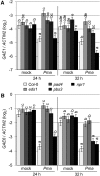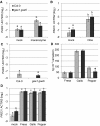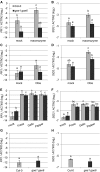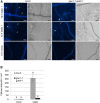Pectin Biosynthesis Is Critical for Cell Wall Integrity and Immunity in Arabidopsis thaliana
- PMID: 26813622
- PMCID: PMC4790862
- DOI: 10.1105/tpc.15.00404
Pectin Biosynthesis Is Critical for Cell Wall Integrity and Immunity in Arabidopsis thaliana
Abstract
Plant cell walls are important barriers against microbial pathogens. Cell walls of Arabidopsis thaliana leaves contain three major types of polysaccharides: cellulose, various hemicelluloses, and pectins. UDP-D-galacturonic acid, the key building block of pectins, is produced from the precursor UDP-D-glucuronic acid by the action of glucuronate 4-epimerases (GAEs). Pseudomonas syringae pv maculicola ES4326 (Pma ES4326) repressed expression of GAE1 and GAE6 in Arabidopsis, and immunity to Pma ES4326 was compromised in gae6 and gae1 gae6 mutant plants. These plants had brittle leaves and cell walls of leaves had less galacturonic acid. Resistance to specific Botrytis cinerea isolates was also compromised in gae1 gae6 double mutant plants. Although oligogalacturonide (OG)-induced immune signaling was unaltered in gae1 gae6 mutant plants, immune signaling induced by a commercial pectinase, macerozyme, was reduced. Macerozyme treatment or infection with B. cinerea released less soluble uronic acid, likely reflecting fewer OGs, from gae1 gae6 cell walls than from wild-type Col-0. Although both OGs and macerozyme-induced immunity to B. cinerea in Col-0, only OGs also induced immunity in gae1 gae6. Pectin is thus an important contributor to plant immunity, and this is due at least in part to the induction of immune responses by soluble pectin, likely OGs, that are released during plant-pathogen interactions.
© 2016 American Society of Plant Biologists. All rights reserved.
Figures













Similar articles
-
Arabidopsis PECTIN METHYLESTERASEs contribute to immunity against Pseudomonas syringae.Plant Physiol. 2014 Feb;164(2):1093-107. doi: 10.1104/pp.113.227637. Epub 2013 Dec 23. Plant Physiol. 2014. PMID: 24367018 Free PMC article.
-
Oligogalacturonide production upon Arabidopsis thaliana-Botrytis cinerea interaction.Proc Natl Acad Sci U S A. 2019 Sep 24;116(39):19743-19752. doi: 10.1073/pnas.1900317116. Epub 2019 Sep 9. Proc Natl Acad Sci U S A. 2019. PMID: 31501325 Free PMC article.
-
Three Pectin Methylesterase Inhibitors Protect Cell Wall Integrity for Arabidopsis Immunity to Botrytis.Plant Physiol. 2017 Mar;173(3):1844-1863. doi: 10.1104/pp.16.01185. Epub 2017 Jan 12. Plant Physiol. 2017. PMID: 28082716 Free PMC article.
-
Methyl esterification of pectin plays a role during plant-pathogen interactions and affects plant resistance to diseases.J Plant Physiol. 2012 Nov 1;169(16):1623-30. doi: 10.1016/j.jplph.2012.05.006. Epub 2012 Jun 18. J Plant Physiol. 2012. PMID: 22717136 Review.
-
Plant cell wall-mediated immunity: cell wall changes trigger disease resistance responses.Plant J. 2018 Feb;93(4):614-636. doi: 10.1111/tpj.13807. Epub 2018 Feb 2. Plant J. 2018. PMID: 29266460 Review.
Cited by
-
The Resistance of Maize to Ustilago maydis Infection Is Correlated with the Degree of Methyl Esterification of Pectin in the Cell Wall.Int J Mol Sci. 2023 Sep 29;24(19):14737. doi: 10.3390/ijms241914737. Int J Mol Sci. 2023. PMID: 37834187 Free PMC article.
-
Ectopic Defense Gene Expression Is Associated with Growth Defects in Medicago truncatula Lignin Pathway Mutants.Plant Physiol. 2019 Sep;181(1):63-84. doi: 10.1104/pp.19.00533. Epub 2019 Jul 9. Plant Physiol. 2019. PMID: 31289215 Free PMC article.
-
Changes of cell wall components during embryogenesis of Castanea mollissima.J Plant Res. 2020 Mar;133(2):257-270. doi: 10.1007/s10265-020-01170-7. Epub 2020 Feb 8. J Plant Res. 2020. PMID: 32036472
-
How the Depletion in Mineral Major Elements Affects Grapevine (Vitis vinifera L.) Primary Cell Wall.Front Plant Sci. 2017 Aug 21;8:1439. doi: 10.3389/fpls.2017.01439. eCollection 2017. Front Plant Sci. 2017. PMID: 28871267 Free PMC article. Review.
-
Arabidopsis cell wall composition determines disease resistance specificity and fitness.Proc Natl Acad Sci U S A. 2021 Feb 2;118(5):e2010243118. doi: 10.1073/pnas.2010243118. Proc Natl Acad Sci U S A. 2021. PMID: 33509925 Free PMC article.
References
-
- Adam L., Somerville S.C. (1996). Genetic characterization of five powdery mildew disease resistance loci in Arabidopsis thaliana. Plant J. 9: 341–356. - PubMed
-
- Albersheim P., Jones T.M., English P.D. (1969). Biochemistry of the cell wall in relation to infective processes. Annu. Rev. Phytopathol. 7: 171–194. - PubMed
-
- Alonso J.M., et al. (2003). Genome-wide insertional mutagenesis of Arabidopsis thaliana. Science 301: 653–657. - PubMed
-
- Asai T., Tena G., Plotnikova J., Willmann M.R., Chiu W.L., Gomez-Gomez L., Boller T., Ausubel F.M., Sheen J. (2002). MAP kinase signalling cascade in Arabidopsis innate immunity. Nature 415: 977–983. - PubMed
-
- Bartsch M., Gobbato E., Bednarek P., Debey S., Schultze J.L., Bautor J., Parker J.E. (2006). Salicylic acid-independent ENHANCED DISEASE SUSCEPTIBILITY1 signaling in Arabidopsis immunity and cell death is regulated by the monooxygenase FMO1 and the Nudix hydrolase NUDT7. Plant Cell 18: 1038–1051. - PMC - PubMed
Publication types
MeSH terms
Substances
LinkOut - more resources
Full Text Sources
Other Literature Sources
Molecular Biology Databases
Miscellaneous

